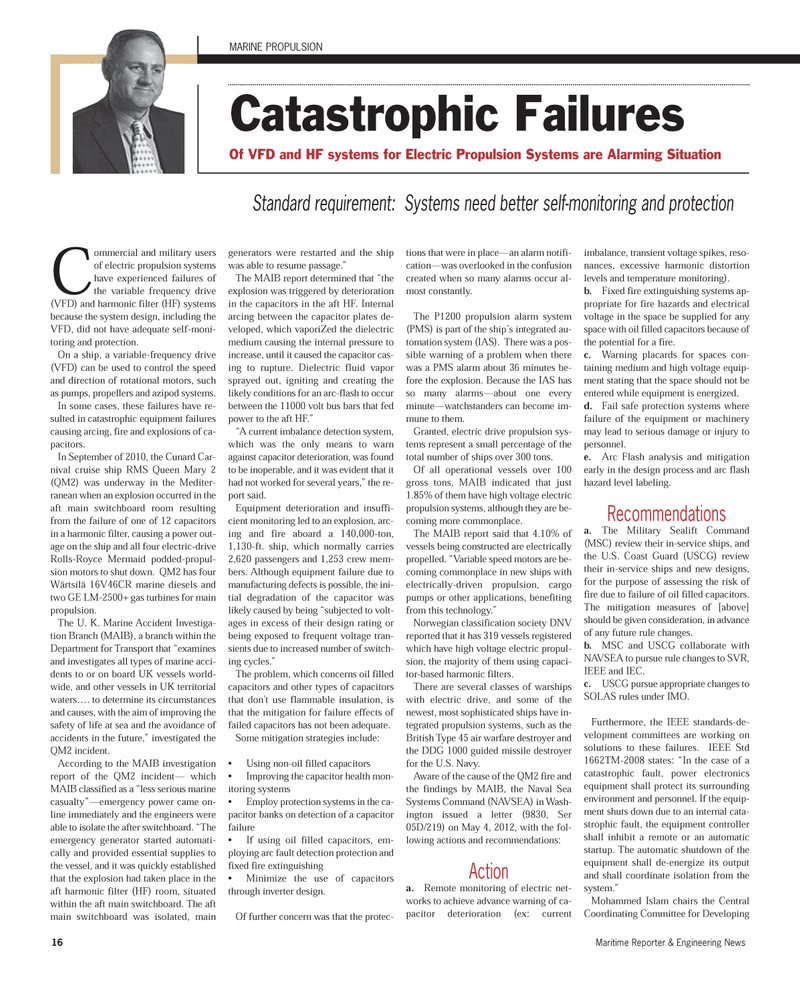
Page 16: of Maritime Reporter Magazine (July 2012)
Arctic Operations
Read this page in Pdf, Flash or Html5 edition of July 2012 Maritime Reporter Magazine
16Maritime Reporter & Engineering News Commercial and military usersof electric propulsion systemshave experienced failures of the variable frequency drive (VFD) and harmonic filter (HF) systems because the system design, including theVFD, did not have adequate self-moni- toring and protection.On a ship, a variable-frequency drive (VFD) can be used to control the speedand direction of rotational motors, suchas pumps, propellers and azipod systems.In some cases, these failures have re- sulted in catastrophic equipment failures causing arcing, fire and explosions of ca- pacitors. In September of 2010, the Cunard Car- nival cruise ship RMS Queen Mary 2 (QM2) was underway in the Mediter- ranean when an explosion occurred in the aft main switchboard room resultingfrom the failure of one of 12 capacitors in a harmonic filter, causing a power out- age on the ship and all four electric-drive Rolls-Royce Mermaid podded-propul- sion motors to shut down. QM2 has four Wärtsilä 16V46CR marine diesels andtwo GE LM-2500+ gas turbines for main propulsion.The U. K. Marine Accident Investiga- tion Branch (MAIB), a branch within theDepartment for Transport that ?examines and investigates all types of marine acci- dents to or on board UK vessels world- wide, and other vessels in UK territorial waters?. to determine its circumstances and causes, with the aim of improving the safety of life at sea and the avoidance of accidents in the future,? investigated the QM2 incident.According to the MAIB investigation report of the QM2 incident? whichMAIB classified as a ?less serious marine casualty??emergency power came on- line immediately and the engineers wereable to isolate the after switchboard. ?Theemergency generator started automati- cally and provided essential supplies to the vessel, and it was quickly established that the explosion had taken place in the aft harmonic filter (HF) room, situated within the aft main switchboard. The aft main switchboard was isolated, main generators were restarted and the shipwas able to resume passage.? The MAIB report determined that ?theexplosion was triggered by deterioration in the capacitors in the aft HF. Internal arcing between the capacitor plates de-veloped, which vaporiZed the dielectric medium causing the internal pressure toincrease, until it caused the capacitor cas-ing to rupture. Dielectric fluid vapor sprayed out, igniting and creating thelikely conditions for an arc-flash to occur between the 11000 volt bus bars that fed power to the aft HF.? ?A current imbalance detection system, which was the only means to warn against capacitor deterioration, was found to be inoperable, and it was evident that it had not worked for several years,? the re- port said. Equipment deterioration and insuffi- cient monitoring led to an explosion, arc- ing and fire aboard a 140,000-ton, 1,130-ft. ship, which normally carries2,620 passengers and 1,253 crew mem- bers. Although equipment failure due to manufacturing defects is possible, the ini- tial degradation of the capacitor was likely caused by being ?subjected to volt- ages in excess of their design rating or being exposed to frequent voltage tran- sients due to increased number of switch-ing cycles.? The problem, which concerns oil filled capacitors and other types of capacitorsthat don't use flammable insulation, isthat the mitigation for failure effects of failed capacitors has not been adequate. Some mitigation strategies include: Using non-oil filled capacitors Improving the capacitor health mon- itoring systemsEmploy protection systems in the ca- pacitor banks on detection of a capacitorfailure If using oil filled capacitors, em- ploying arc fault detection protection and fixed fire extinguishing Minimize the use of capacitors through inverter design. Of further concern was that the protec- tions that were in place?an alarm notifi- cation?was overlooked in the confusion created when so many alarms occur al- most constantly. The P1200 propulsion alarm system(PMS) is part of the ship?s integrated au- tomation system (IAS). There was a pos- sible warning of a problem when there was a PMS alarm about 36 minutes be- fore the explosion. Because the IAS has so many alarms?about one every minute?watchstanders can become im- mune to them.Granted, electric drive propulsion sys- tems represent a small percentage of thetotal number of ships over 300 tons. Of all operational vessels over 100 gross tons, MAIB indicated that just1.85% of them have high voltage electric propulsion systems, although they are be- coming more commonplace. The MAIB report said that 4.10% ofvessels being constructed are electrically propelled. ?Variable speed motors are be- coming commonplace in new ships with electrically-driven propulsion, cargo pumps or other applications, benefiting from this technology.? Norwegian classification society DNV reported that it has 319 vessels registered which have high voltage electric propul- sion, the majority of them using capaci-tor-based harmonic filters. There are several classes of warships with electric drive, and some of the newest, most sophisticated ships have in- tegrated propulsion systems, such as the British Type 45 air warfare destroyer and the DDG 1000 guided missile destroyer for the U.S. Navy. Aware of the cause of the QM2 fire and the findings by MAIB, the Naval Sea Systems Command (NAVSEA) in Wash- ington issued a letter (9830, Ser05D/219) on May 4, 2012, with the fol-lowing actions and recommendations: Actiona.Remote monitoring of electric net-works to achieve advance warning of ca- pacitor deterioration (ex: current imbalance, transient voltage spikes, reso- nances, excessive harmonic distortion levels and temperature monitoring). b.Fixed fire extinguishing systems ap- propriate for fire hazards and electrical voltage in the space be supplied for any space with oil filled capacitors because of the potential for a fire. c.Warning placards for spaces con- taining medium and high voltage equip- ment stating that the space should not beentered while equipment is energized. d.Fail safe protection systems where failure of the equipment or machinery may lead to serious damage or injury topersonnel.e.Arc Flash analysis and mitigation early in the design process and arc flashhazard level labeling. Recommendationsa.The Military Sealift Command(MSC) review their in-service ships, and the U.S. Coast Guard (USCG) review their in-service ships and new designs, for the purpose of assessing the risk offire due to failure of oil filled capacitors. The mitigation measures of [above] should be given consideration, in advance of any future rule changes. b.MSC and USCG collaborate withNAVSEA to pursue rule changes to SVR, IEEE and IEC.c.USCG pursue appropriate changes toSOLAS rules under IMO.Furthermore, the IEEE standards-de-velopment committees are working on solutions to these failures. IEEE Std 1662TM-2008 states: ?In the case of acatastrophic fault, power electronics equipment shall protect its surroundingenvironment and personnel. If the equip- ment shuts down due to an internal cata- strophic fault, the equipment controller shall inhibit a remote or an automaticstartup. The automatic shutdown of the equipment shall de-energize its output and shall coordinate isolation from thesystem.? Mohammed Islam chairs the CentralCoordinating Committee for Developing MARINE PROPULSIONCatastrophic Failures Of VFD and HF systems for Electric Propulsion Systems are Alarming Situation Standard requirement: Systems need better self-monitoring and protection MR#7 (10-17):MR Template 7/6/2012 10:03 AM Page 16

 15
15

 17
17
